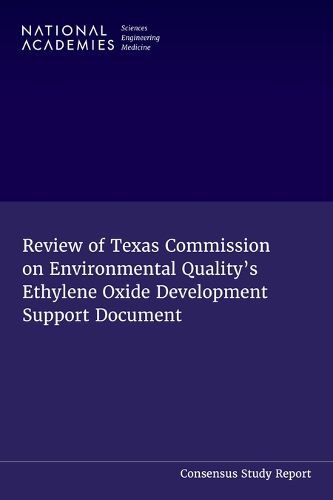Readings Newsletter
Become a Readings Member to make your shopping experience even easier.
Sign in or sign up for free!
You’re not far away from qualifying for FREE standard shipping within Australia
You’ve qualified for FREE standard shipping within Australia
The cart is loading…






Ethylene oxide is primarily produced in Texas and Louisiana with sites in Texas accounting for nearly half of all emitted ethylene oxide in the United States. Because ethylene oxide is emitted in Texas and has been determined by other agencies to be a carcinogen, the Texas Commission on Environmental Quality (TCEQ) undertook a carcinogenic dose-response assessment for use in TCEQ's remediation and air permitting programs. The TCEQ assessed the carcinogenic hazards of ethylene oxide and derived a chronic inhalation unit risk factor (URF) in its 2020 Ethylene Oxide Carcinogenic Dose-Response Assessment Development Support Document (TCEQ DSD).
As requested by TCEQ, the National Academies of Sciences, Engineering, and Medicine assembled an ad hoc committee to review the methods, results, and conclusions of the TCEQ DSD. The committee considered whether the conclusions are clearly presented, scientifically supported, and based on the best available scientific information. The report finds that the lack of application of systematic review methods, the exclusion of critical epidemiological data, the limitations in the modeling approach and use of unpublished validation data all contribute to a lack of confidence in TCEQ's risk assessment of ethylene oxide.
Table of Contents
Front Matter Summary 1 Introduction 2 Hazard Identification 3 Dose-Response References Appendix A: Committee Biographies Appendix B: Public Meeting Agenda
$9.00 standard shipping within Australia
FREE standard shipping within Australia for orders over $100.00
Express & International shipping calculated at checkout
Ethylene oxide is primarily produced in Texas and Louisiana with sites in Texas accounting for nearly half of all emitted ethylene oxide in the United States. Because ethylene oxide is emitted in Texas and has been determined by other agencies to be a carcinogen, the Texas Commission on Environmental Quality (TCEQ) undertook a carcinogenic dose-response assessment for use in TCEQ's remediation and air permitting programs. The TCEQ assessed the carcinogenic hazards of ethylene oxide and derived a chronic inhalation unit risk factor (URF) in its 2020 Ethylene Oxide Carcinogenic Dose-Response Assessment Development Support Document (TCEQ DSD).
As requested by TCEQ, the National Academies of Sciences, Engineering, and Medicine assembled an ad hoc committee to review the methods, results, and conclusions of the TCEQ DSD. The committee considered whether the conclusions are clearly presented, scientifically supported, and based on the best available scientific information. The report finds that the lack of application of systematic review methods, the exclusion of critical epidemiological data, the limitations in the modeling approach and use of unpublished validation data all contribute to a lack of confidence in TCEQ's risk assessment of ethylene oxide.
Table of Contents
Front Matter Summary 1 Introduction 2 Hazard Identification 3 Dose-Response References Appendix A: Committee Biographies Appendix B: Public Meeting Agenda